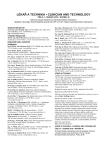CELL-BASED SENSOR CHIP FOR NEUROTOXICITY MEASUREMENTS IN DRINKING WATER
Our drinking water contains residues of pharmaceuticals. A sub-group of these contaminants are neuro-active substances, the antiepileptic carbamazepine being one of the most relevant. For assessment of the neurotoxicity of this drug at a sub-therapeutic level, a cell-based sensor chip platform has been realized and characterized. For this purpose, a microelectrode array chip was designed and processed in a clean room and optimized in terms of low processing costs and good recording properties. For characterization of the system neuronal cells were plated on microelectrode array chips and electrical activity was measured as a function of applied carbamazepine concentration. We found that the relative spike rate decreased with increasing drug concentration resulted in IC50 values of around 36 μM. This value is five orders of magnitude higher than the maximal dose found in drinking water. IC50 values for burst rate, burst duration and synchrony were slightly higher, suggesting spike rate being a more sensitive parameter to carbamazepine.
Keywords:
Microelectrode array, carbamazepine, neurotoxicity, cell-based biosensor
Autoři:
Dennis Flachs; Manuel Ciba
Působiště autorů:
BioMEMS Lab, Faculty of Engineering, University of Applied Sciences Aschaffenburg, Germany
Vyšlo v časopise:
Lékař a technika - Clinician and Technology No. 2, 2016, 46, 46-50
Kategorie:
Původní práce
Souhrn
Our drinking water contains residues of pharmaceuticals. A sub-group of these contaminants are neuro-active substances, the antiepileptic carbamazepine being one of the most relevant. For assessment of the neurotoxicity of this drug at a sub-therapeutic level, a cell-based sensor chip platform has been realized and characterized. For this purpose, a microelectrode array chip was designed and processed in a clean room and optimized in terms of low processing costs and good recording properties. For characterization of the system neuronal cells were plated on microelectrode array chips and electrical activity was measured as a function of applied carbamazepine concentration. We found that the relative spike rate decreased with increasing drug concentration resulted in IC50 values of around 36 μM. This value is five orders of magnitude higher than the maximal dose found in drinking water. IC50 values for burst rate, burst duration and synchrony were slightly higher, suggesting spike rate being a more sensitive parameter to carbamazepine.
Keywords:
Microelectrode array, carbamazepine, neurotoxicity, cell-based biosensor
Zdroje
[1] Bergmann, A., Fohrmann, R., Weber, F.-A. Zusammenstellung von Monitoringdaten zu Umweltkonzentrationen von Arznei-mitteln. Umweltbundesamt, 2011.
[2] Webb, S., Ternes, T., Gibert, M., Olejniczak, K. Indirect human exposure to pharmaceuticals via drinking water. Toxicology letters, 2003, vol. 14, no.3, p. 157–167.
[3] Bergmann, A., Fohrmann, R., Hembrock-Heger, A. Bewertung der Umweltrelevanz von Arzneistoffen. Umweltwissenschaften und Schadstoff-Forschung, 2008, 20(3):197–208.
[4] Boutrup, S., Jaakko, M., Dam, M., Mønster, T. PPCP monitoring in the Nordic Countries - Status Report. Nordic Council of Ministers, 2012.
[5] Rönnefahrt, R., Amato, Ebert, I., Schönfeld, J. Arzneimittel in der Umwelt–Ein Risiko? UMID: Umwelt und Mensch–Informationsdienst, 2012, 1 : 36–43.
[6] Sheets, P. L., Heers, C., Stoer, T., Cummins, T. R. Differential block of sensory neuronal voltage-gated sodium channels by lacosamide [(2R)-2-(acetylamino)-N-benzyl-3-methoxypropanamide], lidocaine, and carbamazepine. Journal of Pharmacology and Experimental Therapeutics, 2008, vol. 326, no. 1, p. 89–99.
[7] Liu, L., et al. The mechanism of carbamazepine aggravation of absence seizures. Journal of Pharmacology and Experimental Therapeutics, 2006, 319.2, 790-798.
[8] Ternes, T. A. Occurrence of drugs in German sewage treatment plants and rivers. Water research, 1998, 32.11, 3245-3260.
[9] Fatta-Kassinos, D., et al. Existence of pharmaceutical compounds in tertiary treated urban wastewater that is utilized for reuse applications. Water resources management, 2011, 25.4, 1183-1193.
[10] Johnstone, A. F., et al. Microelectrode arrays: a physiologically based neurotoxicity testing platform for the 21st century. Neurotoxicology, 2010, vol. 31, no. 4, p. 331–350.
[11] Daus, A.W., Layer P.G., Thielemann, C. A spheroid-based biosensor for the label-free detection of drug-induced field potential alterations. Sensors and Actuators B: Chemical, 2012, vol. 165, p. 53-58.
[12] Nick, C., Goldhammer, M., Bestel, R., Steger, F., Daus, A. W., Thielemann , C. DrCell – A Software Tool for the Analysis of Cell Signals recorded with Extracellular Microelectrodes. Signal Proc Int J, 2013, vol. 7, no. 2, p. 96-109.
[13] Baker R. E., Corner M. A., Pelt J. Spontaneous neuronal discharge patterns in developing organotypic mega-co-cultures of neonatal rat cerebral cortex. Brain research, 2006, 1101(1):29–35.
[14] Selinger, J. V., Pancrazio, J. J., Gross, G. Measuring synchronization in neuronal networks for biosensor applications. Biosensors and Bioelectronics, 2004, 19.7, 675-683.
[15] Motohashi, N., Ikawa, K., Kariya, T. GABAB receptors are up-regulated by chronic treatment with lithium or carbamazepine. GABA hypothesis of affective disorders. European journal of pharmacology, 1989, 166(1):95–99.
[16] Gopal, K. V. Neurotoxic effects of mercury on auditory cortex networks growing on microelectrode arrays: a preliminary analysis. Neurotoxicology and teratology, 2003, 25(1):69–76.
[17] Hogberg, H. T., et al. Application of micro-electrode arrays (MEAs) as an emerging technology for developmental neurotoxicity: evaluation of domoic acid-induced effects in primary cultures of rat cortical neurons. Neurotoxicology, 2011, 32(1):158–168.
Štítky
BiomedicínaČlánok vyšiel v časopise
Lékař a technika

2016 Číslo 2
Najčítanejšie v tomto čísle
- EARLY DISCHARGE (48–72 HOURS) AFTER ACUTE ST-SEGMENT ELEVATION MYOCARDIAL INFARCTION: INTERIM RESULTS OF THE OPEN, RANDOMIZED, MONOCENTRIC STUDY
- CELL-BASED SENSOR CHIP FOR NEUROTOXICITY MEASUREMENTS IN DRINKING WATER
- TESTING A SYSTEM FOR PREDICTING MICROSLEEP
- DESIGN CONCEPTS FOR PREVENTING GAS BUBBLE INTERFERENCE IN MICROFLUIDIC DEVICES
